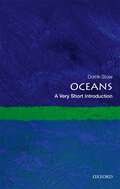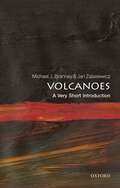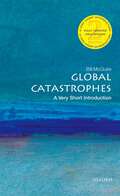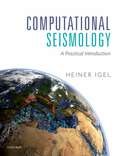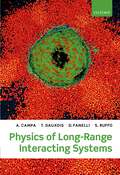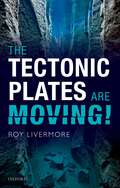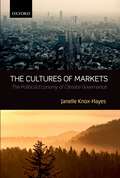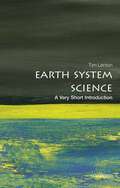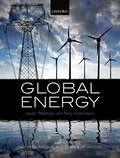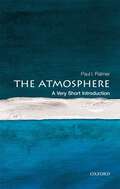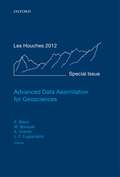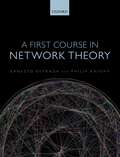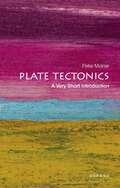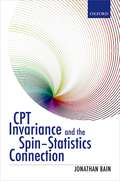- Table View
- List View
Oceans: A Very Short Introduction (Very Short Introductions)
by Dorrik StowThe importance of the oceans to life on Earth cannot be overstated. Liquid water covers more than 70% of our planet's surface and, in past geological time, has spread over 85%. Life on Earth began in the oceans over 3.5 billion years ago and remained there for the great majority of that time. Today the seas still provide 99% of habitable living space, the largest repository of biomass, and holds the greatest number of undiscovered species on the planet. Our oceans are vital for the regulation of climate, and with global warming and decreasing land area, they have become increasingly important as the source of food, energy in the form of oil and gas, and for their mineral wealth. Oceans also form a key part of the biogeochemical cycles of carbon, nitrogen, and other elements critical to life. Nutrients in upwelling areas are spread by ocean currents, and the plankton of the seas supports a wealth of wildlife. In this Very Short Introduction Dorrik Stow analyses these most important components of our blue planet and considers their relationship with, and exploitation by, humans. He shows how the oceans are an essential resource to our overpopulated world, and discusses why exploration and greater scientific understanding of the oceans, their chemistry, and their mineral wealth are now a high priority. Stow also explores what we know of how oceans originate, and evolve and change; the shape of the seafloor and nature of its cover; the physical processes that stir the waters and mix such a rich chemical broth; and the inseparable link between oceans and climate. As polar ice melts and sea-levels rise, countless millions who have made their homes on low-lying lands close to the sea are threatened. As scientific exploration of the seas gathers pace, the new knowledge gained of the ocean-Earth systems and their interaction with the human environment is vital to our understanding of how we can preserve these ultimately fragile environments. ABOUT THE SERIES: The Very Short Introductions series from Oxford University Press contains hundreds of titles in almost every subject area. These pocket-sized books are the perfect way to get ahead in a new subject quickly. Our expert authors combine facts, analysis, perspective, new ideas, and enthusiasm to make interesting and challenging topics highly readable.
Oceans: How Tethys Reshaped The World (Very Short Introductions)
by Dorrik StowThe importance of the oceans to life on Earth cannot be overstated. Liquid water covers more than 70% of our planet's surface and, in past geological time, has spread over 85%. Life on Earth began in the oceans over 3.5 billion years ago and remained there for the great majority of that time. Today the seas still provide 99% of habitable living space, the largest repository of biomass, and holds the greatest number of undiscovered species on the planet. Our oceans are vital for the regulation of climate, and with global warming and decreasing land area, they have become increasingly important as the source of food, energy in the form of oil and gas, and for their mineral wealth. Oceans also form a key part of the biogeochemical cycles of carbon, nitrogen, and other elements critical to life. Nutrients in upwelling areas are spread by ocean currents, and the plankton of the seas supports a wealth of wildlife. In this Very Short Introduction Dorrik Stow analyses these most important components of our blue planet and considers their relationship with, and exploitation by, humans. He shows how the oceans are an essential resource to our overpopulated world, and discusses why exploration and greater scientific understanding of the oceans, their chemistry, and their mineral wealth are now a high priority. Stow also explores what we know of how oceans originate, and evolve and change; the shape of the seafloor and nature of its cover; the physical processes that stir the waters and mix such a rich chemical broth; and the inseparable link between oceans and climate. As polar ice melts and sea-levels rise, countless millions who have made their homes on low-lying lands close to the sea are threatened. As scientific exploration of the seas gathers pace, the new knowledge gained of the ocean-Earth systems and their interaction with the human environment is vital to our understanding of how we can preserve these ultimately fragile environments. ABOUT THE SERIES: The Very Short Introductions series from Oxford University Press contains hundreds of titles in almost every subject area. These pocket-sized books are the perfect way to get ahead in a new subject quickly. Our expert authors combine facts, analysis, perspective, new ideas, and enthusiasm to make interesting and challenging topics highly readable.
Volcanoes: A Very Short Introduction (Very Short Introductions)
by Michael J Branney Jan ZalasiewiczVolcanoes are some of the most dramatic expressions of the powerful tectonic forces at work in the Earth beneath our feet. But volcanism, a profoundly important feature of Earth, and indeed of other planets and moons too, encompasses much more than just volcanoes themselves. On a planetary scale, volcanism is an indispensable heat release mechanism, which on Earth allows the conditions for life. IIt releases gases into the atmosphere and produces enormous volumes of rock, and spectacular landscapes - landscapes which, during major eruptions, can be completely reshaped in a matter of hours. Through geological time volcanism has shaped both climate and biological evolution, and volcanoes can affect human life, too, for both good and ill. Yet, even after much study, some of the fundamental aspects of volcanicity remain mysterious. This Very Short Introduction takes the readers into the inferno of a racing pyroclastic current, and the heart of a moving lava flow, as understood through the latest scientific research. Exploring how volcanologists forensically decipher how volcanoes work, Michael Branney and Jan Zalasiewicz explain what we do (and don't) understood about the fundamental mechanisms of volcanism, and consider how volcanoes interact with other physical processes on the Earth, with life, and with human society. ABOUT THE SERIES: The Very Short Introductions series from Oxford University Press contains hundreds of titles in almost every subject area. These pocket-sized books are the perfect way to get ahead in a new subject quickly. Our expert authors combine facts, analysis, perspective, new ideas, and enthusiasm to make interesting and challenging topics highly readable.
Volcanoes: A Very Short Introduction (Very Short Introductions)
by Jan Zalasiewicz Michael J BranneyVolcanoes are some of the most dramatic expressions of the powerful tectonic forces at work in the Earth beneath our feet. But volcanism, a profoundly important feature of Earth, and indeed of other planets and moons too, encompasses much more than just volcanoes themselves. On a planetary scale, volcanism is an indispensable heat release mechanism, which on Earth allows the conditions for life. IIt releases gases into the atmosphere and produces enormous volumes of rock, and spectacular landscapes - landscapes which, during major eruptions, can be completely reshaped in a matter of hours. Through geological time volcanism has shaped both climate and biological evolution, and volcanoes can affect human life, too, for both good and ill. Yet, even after much study, some of the fundamental aspects of volcanicity remain mysterious. This Very Short Introduction takes the readers into the inferno of a racing pyroclastic current, and the heart of a moving lava flow, as understood through the latest scientific research. Exploring how volcanologists forensically decipher how volcanoes work, Michael Branney and Jan Zalasiewicz explain what we do (and don't) understood about the fundamental mechanisms of volcanism, and consider how volcanoes interact with other physical processes on the Earth, with life, and with human society. ABOUT THE SERIES: The Very Short Introductions series from Oxford University Press contains hundreds of titles in almost every subject area. These pocket-sized books are the perfect way to get ahead in a new subject quickly. Our expert authors combine facts, analysis, perspective, new ideas, and enthusiasm to make interesting and challenging topics highly readable.
Global Catastrophes: A Very Short Introduction (Very Short Introductions)
by Bill McGuireLife on earth will come to an end. It's just a matter of when. In this Very Short Introduction, Bill McGuire explores the many potential catastrophes facing our planet and our species in the future, and looks at both the probability of these events happening and our chances of survival. From the likely consequences of global warming to the inevitable destruction of the earth in the far future, McGuire considers a range of 'end of the world scenarios', including the New Ice Age, asteroid and comet impact, supervolcanoes, and mega-tsunami. Updated with a number of recent case studies from around the world, this new edition brings our understanding of global disasters and risk research up to date. ABOUT THE SERIES: The Very Short Introductions series from Oxford University Press contains hundreds of titles in almost every subject area. These pocket-sized books are the perfect way to get ahead in a new subject quickly. Our expert authors combine facts, analysis, perspective, new ideas, and enthusiasm to make interesting and challenging topics highly readable.
Savannas: A Very Short Introduction (Very Short Introductions)
by Peter A. FurleySavannas form one of the largest and most important of the world's ecological zones. Covering one fifth of the Earth's land surface, they are home to some of the world's most iconic animals and form an extremely important global resource for plants and wildlife. However, increasing recognition of their land potential means that they are extremely vulnerable to accelerating pressures on usable land. This Very Short Introduction considers savannas as landscapes. Discussing their origin, topography, and global distribution, Peter A. Furley explores the dynamic nature of savannas and illustrates how they have shaped human evolution and movements. He goes on to discuss the unrelenting pressures that confront conservation and management and considers the future for savannas. ABOUT THE SERIES: The Very Short Introductions series from Oxford University Press contains hundreds of titles in almost every subject area. These pocket-sized books are the perfect way to get ahead in a new subject quickly. Our expert authors combine facts, analysis, perspective, new ideas, and enthusiasm to make interesting and challenging topics highly readable.
Savannas: A Very Short Introduction (Very Short Introductions)
by Peter A. FurleySavannas form one of the largest and most important of the world's ecological zones. Covering one fifth of the Earth's land surface, they are home to some of the world's most iconic animals and form an extremely important global resource for plants and wildlife. However, increasing recognition of their land potential means that they are extremely vulnerable to accelerating pressures on usable land. This Very Short Introduction considers savannas as landscapes. Discussing their origin, topography, and global distribution, Peter A. Furley explores the dynamic nature of savannas and illustrates how they have shaped human evolution and movements. He goes on to discuss the unrelenting pressures that confront conservation and management and considers the future for savannas. ABOUT THE SERIES: The Very Short Introductions series from Oxford University Press contains hundreds of titles in almost every subject area. These pocket-sized books are the perfect way to get ahead in a new subject quickly. Our expert authors combine facts, analysis, perspective, new ideas, and enthusiasm to make interesting and challenging topics highly readable.
Computational Seismology: A Practical Introduction
by Heiner IgelThis book is an introductory text to a range of numerical methods used today to simulate time-dependent processes in Earth science, physics, engineering, and many other fields. The physical problem of elastic wave propagation in 1D serves as a model system with which the various numerical methods are introduced and compared. The theoretical background is presented with substantial graphical material supporting the concepts. The results can be reproduced with the supplementary electronic material provided as python codes embedded in Jupyter notebooks. The book starts with a primer on the physics of elastic wave propagation, and a chapter on the fundamentals of parallel programming, computational grids, mesh generation, and hardware models. The core of the book is the presentation of numerical solutions of the wave equation with six different methods: 1) the finite-difference method; 2) the pseudospectral method (Fourier and Chebyshev); 3) the linear finite-element method; 4) the spectral-element method; 5) the finite-volume method; and 6) the discontinuous Galerkin method. Each chapter contains comprehension questions, theoretical, and programming exercises. The book closes with a discussion of domains of application and criteria for the choice of a specific numerical method, and the presentation of current challenges.
Physics of Long-Range Interacting Systems
by A. Campa T. Dauxois D. Fanelli S. RuffoThis book deals with an important class of many-body systems: those where the interaction potential decays slowly for large inter-particle distances; in particular, systems where the decay is slower than the inverse inter-particle distance raised to the dimension of the embedding space. Gravitational and Coulomb interactions are the most prominent examples, however it has become clear that long-range interactions are more common than previously thought. A satisfactory understanding of properties, generally considered as oddities only a couple of decades ago, has now been reached: ensemble inequivalence, negative specific heat, negative susceptibility, ergodicity breaking, out-of-equilibrium quasi-stationary-states, anomalous diffusion. The book, intended for Master and PhD students, tries to gradually acquaint the reader with the subject. The first two parts describe the theoretical and computational instruments needed to address the study of both equilibrium and dynamical properties of systems subject to long-range forces. The third part of the book is devoted to applications of such techniques to the most relevant examples of long-range systems.
The Tectonic Plates are Moving!
by Roy LivermorePlate tectonics is a revolutionary theory on a par with modern genetics. Yet, apart from the frequent use of clichés such as 'tectonic shift' by economists, journalists, and politicians, the science itself is rarely mentioned and poorly understood. This book explains modern plate tectonics in a non-technical manner, showing not only how it accounts for phenomena such as great earthquakes, tsunamis, and volcanic eruptions, but also how it controls conditions at the Earth's surface, including global geography and climate. The book presents the advances that have been made since the establishment of plate tectonics in the 1960s, highlighting, on the 50th anniversary of the theory, the contributions of a small number of scientists who have never been widely recognized for their discoveries. Beginning with the publication of a short article in Nature by Vine and Matthews, the book traces the development of plate tectonics through two generations of the theory. First generation plate tectonics covers the exciting scientific revolution of the 1960s and 1970s, its heroes and its villains. The second generation includes the rapid expansions in sonar, satellite, and seismic technologies during the 1980s and 1990s that provided a truly global view of the plates and their motions, and an appreciation of the role of the plates within the Earth 'system'. The final chapter bring us to the cutting edge of the science, and the latest results from studies using technologies such as seismic tomography and high-pressure mineral physics to probe the deep interior. Ultimately, the book leads to the startling conclusion that, without plate tectonics, the Earth would be as lifeless as Venus.
The Tectonic Plates are Moving!
by Roy LivermorePlate tectonics is a revolutionary theory on a par with modern genetics. Yet, apart from the frequent use of clichés such as 'tectonic shift' by economists, journalists, and politicians, the science itself is rarely mentioned and poorly understood. This book explains modern plate tectonics in a non-technical manner, showing not only how it accounts for phenomena such as great earthquakes, tsunamis, and volcanic eruptions, but also how it controls conditions at the Earth's surface, including global geography and climate. The book presents the advances that have been made since the establishment of plate tectonics in the 1960s, highlighting, on the 50th anniversary of the theory, the contributions of a small number of scientists who have never been widely recognized for their discoveries. Beginning with the publication of a short article in Nature by Vine and Matthews, the book traces the development of plate tectonics through two generations of the theory. First generation plate tectonics covers the exciting scientific revolution of the 1960s and 1970s, its heroes and its villains. The second generation includes the rapid expansions in sonar, satellite, and seismic technologies during the 1980s and 1990s that provided a truly global view of the plates and their motions, and an appreciation of the role of the plates within the Earth 'system'. The final chapter bring us to the cutting edge of the science, and the latest results from studies using technologies such as seismic tomography and high-pressure mineral physics to probe the deep interior. Ultimately, the book leads to the startling conclusion that, without plate tectonics, the Earth would be as lifeless as Venus.
The Cultures of Markets: The Political Economy of Climate Governance
by Janelle Knox-HayesAnthropogenic climate change poses a grave threat to societies around the world. The greenhouse gases that generate climate change are produced by virtually every sector of every economy. The predominant response of governments around the world is to mitigate climate change through the capping and trading of emissions. This book explores the establishment of emissions trading as a form of environmental, market-based governance in the United States, Europe, Australia, South Korea, Japan, and China. The book conceptualizes markets as institutions, and analyzes them as a system of climate governance. To this end, it argues that international efforts to promulgate markets run up against local cultures of markets that shape economic practices and knowledge to different degrees. While the global agenda under the United Nations Framework Convention on Climate Change has sought to develop similar systems to enable interconnected and synchronized emissions reductions, each of the cases analyzed here has produced different results. The markets and climate policies established reflect the syncretic impact of socio-political and cultural context on the institutional transfer of markets. Each country expresses a varying degree of ease or unease with the establishment of markets as systems of climate governance. Exploration of market adaptation adds new insights to theories of varieties of capitalism. The book also examines the material implications of emissions markets on the environment and climatic systems. In sum, the study finds that cultures of markets present a substantial challenge to a universalist prescription for resolving climate change and highlights issues at the interface of political and economic governance in different political economies. This includes issues of citizen, state, and industry participation, and the materiality of economic and financial productivity.
Earth System Science: A Very Short Introduction (Very Short Introductions)
by Tim LentonWhen humanity first glimpsed planet Earth from space, the unity of the system that supports humankind entered the popular consciousness. The concept of the Earth's atmosphere, biosphere, oceans, soil, and rocks operating as a closely interacting system has rapidly gained ground in science. This new field, involving geographers, geologists, biologists, oceanographers, and atmospheric physicists, is known as Earth System Science. In this Very Short Introduction, Tim Lenton considers how a world in which humans could evolve was created; how, as a species, we are now reshaping that world; and what a sustainable future for humanity within the Earth System might look like. Drawing on elements of geology, biology, chemistry, physics, and mathematics, Lenton asks whether Earth System Science can help guide us onto a sustainable course before we alter the Earth system to the point where we destroy ourselves and our current civilisation. ABOUT THE SERIES: The Very Short Introductions series from Oxford University Press contains hundreds of titles in almost every subject area. These pocket-sized books are the perfect way to get ahead in a new subject quickly. Our expert authors combine facts, analysis, perspective, new ideas, and enthusiasm to make interesting and challenging topics highly readable.
Earth System Science: A Very Short Introduction (Very Short Introductions)
by Tim LentonWhen humanity first glimpsed planet Earth from space, the unity of the system that supports humankind entered the popular consciousness. The concept of the Earth's atmosphere, biosphere, oceans, soil, and rocks operating as a closely interacting system has rapidly gained ground in science. This new field, involving geographers, geologists, biologists, oceanographers, and atmospheric physicists, is known as Earth System Science. In this Very Short Introduction, Tim Lenton considers how a world in which humans could evolve was created; how, as a species, we are now reshaping that world; and what a sustainable future for humanity within the Earth System might look like. Drawing on elements of geology, biology, chemistry, physics, and mathematics, Lenton asks whether Earth System Science can help guide us onto a sustainable course before we alter the Earth system to the point where we destroy ourselves and our current civilisation. ABOUT THE SERIES: The Very Short Introductions series from Oxford University Press contains hundreds of titles in almost every subject area. These pocket-sized books are the perfect way to get ahead in a new subject quickly. Our expert authors combine facts, analysis, perspective, new ideas, and enthusiasm to make interesting and challenging topics highly readable.
Global Energy: Issues, Potentials, and Policy Implications
Energy, and access to energy, are essential to human life, civilisation and development. A number of energy issues - including energy security, energy prices and the polluting emissions for energy use - now have high prominence on global agendas of policy and diplomacy. In addressing these and other global energy issues, the purpose of this book is to lay out the broad global energy landscape, exploring how these issues might develop in coming decades, and the implications of such developments for energy policy. There are great uncertainties, which will be identified, in respect of some of these issues, but many of the defining characteristics of the landscape are clear, and the energy policies of all countries will need to be broadly consistent with these if they are to be feasible and achieve their objectives. The book therefore provides information about and analysis of energy and related resources, and the technologies that have been and are being developed to exploit them that is essential to understanding how the global energy system is developing, and how it might develop in the future. But its main focus is the critical economic, social, political and cultural issues that will determine how energy systems will develop and which technologies are deployed, why, by whom, and who will benefit from them. The book has three Parts. Part I sets out the current global context for energy system developments, outlining the essential trends of global energy supply and demand, and atmospheric emissions, from the past and going forward, and their driving forces. Part II explores the options and choices, covering both energy demand and energy supply, facing national and international policymakers as they confront the challenges of the global context outlined in Part I. Part III of the book brings together the discussion in Parts I and II with consideration of possible global energy and environmental futures, and of the energy policy choices which will determine which future actually comes to pass.
The Atmosphere: A Very Short Introduction (Very Short Introductions)
by Paul I. PalmerThe atmosphere is the thin, diffuse fluid that envelops the Earth's surface. Despite its apparent fragility, the existence of this fluid is vital for human and other life on Earth. In this Very Short Introduction Paul Palmer describes the physical and chemical characteristics of different layers in the atmosphere, and shows how the interactions where the atmosphere is in contact with land, ocean, and ice affect its observed physical and chemical properties. He also looks at how movement in the atmosphere, driven by heat from the sun, transports heat from lower latitudes to higher latitudes, and is a fundamental feature of the general circulation in the atmosphere. Finally, Palmer presents an overview of the types of measurements used to understand different parts of the atmosphere, and identifies the future challenges for atmospheric scientists. ABOUT THE SERIES: The Very Short Introductions series from Oxford University Press contains hundreds of titles in almost every subject area. These pocket-sized books are the perfect way to get ahead in a new subject quickly. Our expert authors combine facts, analysis, perspective, new ideas, and enthusiasm to make interesting and challenging topics highly readable.
The Atmosphere: A Very Short Introduction (Very Short Introductions)
by Paul I. PalmerThe atmosphere is the thin, diffuse fluid that envelops the Earth's surface. Despite its apparent fragility, the existence of this fluid is vital for human and other life on Earth. In this Very Short Introduction Paul Palmer describes the physical and chemical characteristics of different layers in the atmosphere, and shows how the interactions where the atmosphere is in contact with land, ocean, and ice affect its observed physical and chemical properties. He also looks at how movement in the atmosphere, driven by heat from the sun, transports heat from lower latitudes to higher latitudes, and is a fundamental feature of the general circulation in the atmosphere. Finally, Palmer presents an overview of the types of measurements used to understand different parts of the atmosphere, and identifies the future challenges for atmospheric scientists. ABOUT THE SERIES: The Very Short Introductions series from Oxford University Press contains hundreds of titles in almost every subject area. These pocket-sized books are the perfect way to get ahead in a new subject quickly. Our expert authors combine facts, analysis, perspective, new ideas, and enthusiasm to make interesting and challenging topics highly readable.
Advanced Data Assimilation for Geosciences: Lecture Notes of the Les Houches School of Physics: Special Issue, June 2012 (Lecture Notes of the Les Houches Summer School)
by Éric Blayo Marc Bocquet Emmanuel Cosme Leticia F. CugliandoloData assimilation aims at determining as accurately as possible the state of a dynamical system by combining heterogeneous sources of information in an optimal way. Generally speaking, the mathematical methods of data assimilation describe algorithms for forming optimal combinations of observations of a system, a numerical model that describes its evolution, and appropriate prior information. Data assimilation has a long history of application to high-dimensional geophysical systems dating back to the 1960s, with application to the estimation of initial conditions for weather forecasts. It has become a major component of numerical forecasting systems in geophysics, and an intensive field of research, with numerous additional applications in oceanography, atmospheric chemistry, and extensions to other geophysical sciences. The physical complexity and the high dimensionality of geophysical systems have led the community of geophysics to make significant contributions to the fundamental theory of data assimilation. This book gathers notes from lectures and seminars given by internationally recognized scientists during a three-week school held in the Les Houches School of physics in 2012, on theoretical and applied data assimilation. It is composed of (i) a series of main lectures, presenting the fundamentals of the most commonly used methods, and the information theory background required to understand and evaluate the role of observations; (ii) a series of specialized lectures, addressing various aspects of data assimilation in detail, from the most recent developments of the theory to the specificities of various thematic applications.
Rocks: A Very Short Introduction (Very Short Introductions)
by Jan ZalasiewiczRocks, more than anything else, underpin our lives. They make up the solid structure of the Earth and of other rocky planets, and are present at the cores of gas giant planets. We live on the rocky surface of the planet, grow our food on weathered debris derived from rocks, and we obtain nearly all of the raw materials with which we found our civilization from rocks. From the Earth's crust to building bricks, rocks contain our sense of planetary history, and are a guide to our future. In this Very Short Introduction Jan Zalsiewicz looks at the nature and variety of rocks, and the processes by which they are formed. Starting from the origin of rocks and their key role in the formation of the Earth, he considers what we know about the deep rocks of the mantle and core, and what rocks can tell us about the evolution of the Earth, and looks at those found in outer space and on other planets. ABOUT THE SERIES: The Very Short Introductions series from Oxford University Press contains hundreds of titles in almost every subject area. These pocket-sized books are the perfect way to get ahead in a new subject quickly. Our expert authors combine facts, analysis, perspective, new ideas, and enthusiasm to make interesting and challenging topics highly readable.
Rocks: A Very Short Introduction (Very Short Introductions)
by Jan ZalasiewiczRocks, more than anything else, underpin our lives. They make up the solid structure of the Earth and of other rocky planets, and are present at the cores of gas giant planets. We live on the rocky surface of the planet, grow our food on weathered debris derived from rocks, and we obtain nearly all of the raw materials with which we found our civilization from rocks. From the Earth's crust to building bricks, rocks contain our sense of planetary history, and are a guide to our future. In this Very Short Introduction Jan Zalsiewicz looks at the nature and variety of rocks, and the processes by which they are formed. Starting from the origin of rocks and their key role in the formation of the Earth, he considers what we know about the deep rocks of the mantle and core, and what rocks can tell us about the evolution of the Earth, and looks at those found in outer space and on other planets. ABOUT THE SERIES: The Very Short Introductions series from Oxford University Press contains hundreds of titles in almost every subject area. These pocket-sized books are the perfect way to get ahead in a new subject quickly. Our expert authors combine facts, analysis, perspective, new ideas, and enthusiasm to make interesting and challenging topics highly readable.
A First Course in Network Theory
by Ernesto Estrada Philip A. KnightThe study of network theory is a highly interdisciplinary field, which has emerged as a major topic of interest in various disciplines ranging from physics and mathematics, to biology and sociology. This book promotes the diverse nature of the study of complex networks by balancing the needs of students from very different backgrounds. It references the most commonly used concepts in network theory, provides examples of their applications in solving practical problems, and clear indications on how to analyse their results. In the first part of the book, students and researchers will discover the quantitative and analytical tools necessary to work with complex networks, including the most basic concepts in network and graph theory, linear and matrix algebra, as well as the physical concepts most frequently used for studying networks. They will also find instruction on some key skills such as how to proof analytic results and how to manipulate empirical network data. The bulk of the text is focused on instructing readers on the most useful tools for modern practitioners of network theory. These include degree distributions, random networks, network fragments, centrality measures, clusters and communities, communicability, and local and global properties of networks. The combination of theory, example and method that are presented in this text, should ready the student to conduct their own analysis of networks with confidence and allow teachers to select appropriate examples and problems to teach this subject in the classroom.
Plate Tectonics: A Very Short Introduction (Very Short Introductions)
by Peter MolnarThe 1960s revealed a new and revolutionary idea in geological thought: that the continents drift with respect to one another. After having been dismissed for decades as absurd, the concept gradually became part of geology's basic principles. We now know that the Earth's crust and upper mantle consist of a small number of rigid plates that move, and there are significant boundaries between pairs of plates, usually known as earthquake belts. Plate tectonics now explains much of the structure and phenomena we see today: how oceans form, widen, and disappear; why earthquakes and volcanoes are found in distinct zones which follow plate boundaries; how the great mountain ranges of the world were built. The impact of plate tectonics is studied closely as these processes continue: the Himalaya continues to grow, the Atlantic is widening, and new oceans are forming. In this Very Short Introduction Peter Molnar provides a succinct and authoritative account of the nature and mechanisms of plate tectonics and its impact on our understanding of Earth. ABOUT THE SERIES: The Very Short Introductions series from Oxford University Press contains hundreds of titles in almost every subject area. These pocket-sized books are the perfect way to get ahead in a new subject quickly. Our expert authors combine facts, analysis, perspective, new ideas, and enthusiasm to make interesting and challenging topics highly readable.
Plate Tectonics: A Very Short Introduction (Very Short Introductions)
by Peter MolnarThe 1960s revealed a new and revolutionary idea in geological thought: that the continents drift with respect to one another. After having been dismissed for decades as absurd, the concept gradually became part of geology's basic principles. We now know that the Earth's crust and upper mantle consist of a small number of rigid plates that move, and there are significant boundaries between pairs of plates, usually known as earthquake belts. Plate tectonics now explains much of the structure and phenomena we see today: how oceans form, widen, and disappear; why earthquakes and volcanoes are found in distinct zones which follow plate boundaries; how the great mountain ranges of the world were built. The impact of plate tectonics is studied closely as these processes continue: the Himalaya continues to grow, the Atlantic is widening, and new oceans are forming. In this Very Short Introduction Peter Molnar provides a succinct and authoritative account of the nature and mechanisms of plate tectonics and its impact on our understanding of Earth. ABOUT THE SERIES: The Very Short Introductions series from Oxford University Press contains hundreds of titles in almost every subject area. These pocket-sized books are the perfect way to get ahead in a new subject quickly. Our expert authors combine facts, analysis, perspective, new ideas, and enthusiasm to make interesting and challenging topics highly readable.
CPT Invariance and the Spin-Statistics Connection
by Jonathan BainThis book seeks to answer the question "What explains CPT invariance and the spin-statistics connection?" These properties play foundational roles in relativistic quantum field theories (RQFTs), are supported by high-precision experiments, and figure into explanations of a wide range of phenomena, from antimatter, to the periodic table of the elements, to superconductors and superfluids. They can be derived in RQFTs by means of the famous CPT and Spin-Statistics theorems; but, the author argues, these theorems cannot be said to explain these properties, at least under standard philosophical accounts of scientific explanation. This is because there are multiple, in some cases incompatible, ways of deriving these theorems, and, secondly, because the theorems fail for the types of theories that underwrite the empirical evidence: non-relativistic quantum theories, and realistic interacting RQFTs. The goal of this book is to work towards an understanding of CPT invariance and the spin-statistics connection by first providing an analysis of the necessary and sufficient conditions for these properties, and second by advocating a particular account of explanation appropriate for this context.
Foundation of Statistical Energy Analysis in Vibroacoustics
by A. Le BotThis book provides an in-depth study of the foundations of statistical energy analysis, with a focus on examining the statistical theory of sound and vibration. In the modal approach, an introduction to random vibration with application to complex systems having a large number of modes is provided. For the wave approach, the phenomena of propagation, group speed, and energy transport are extensively discussed. Particular emphasis is given to the emergence of the diffuse field, the central concept of the theory. All important notions are gradually introduced—-making the text self-contained—-to lead the reader to the ultimate result of `coupling power proportionality' and the concept of `vibrational temperature'. Further key topics include the analogy between thermodynamics and sound vibration. Applications are concerned with random vibration in mass—spring resonators, strings, beams, rods, and plates but also reverberation in room acoustics, radiation of sound, and sound response.
